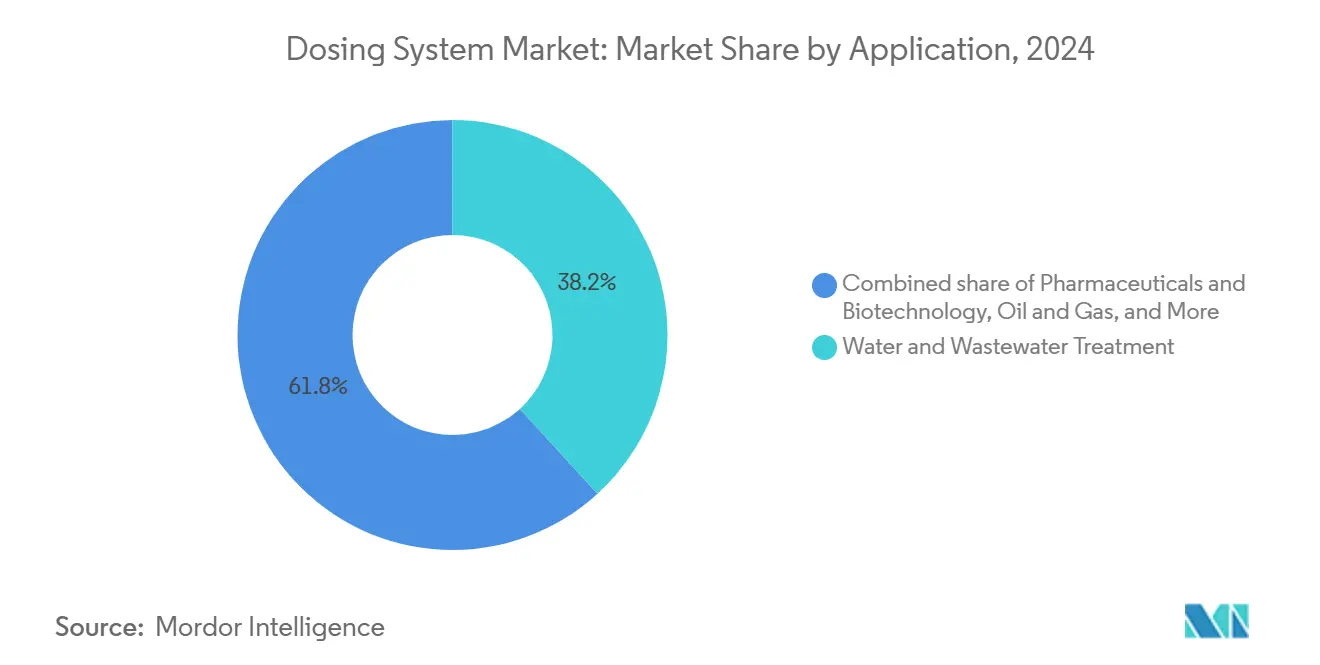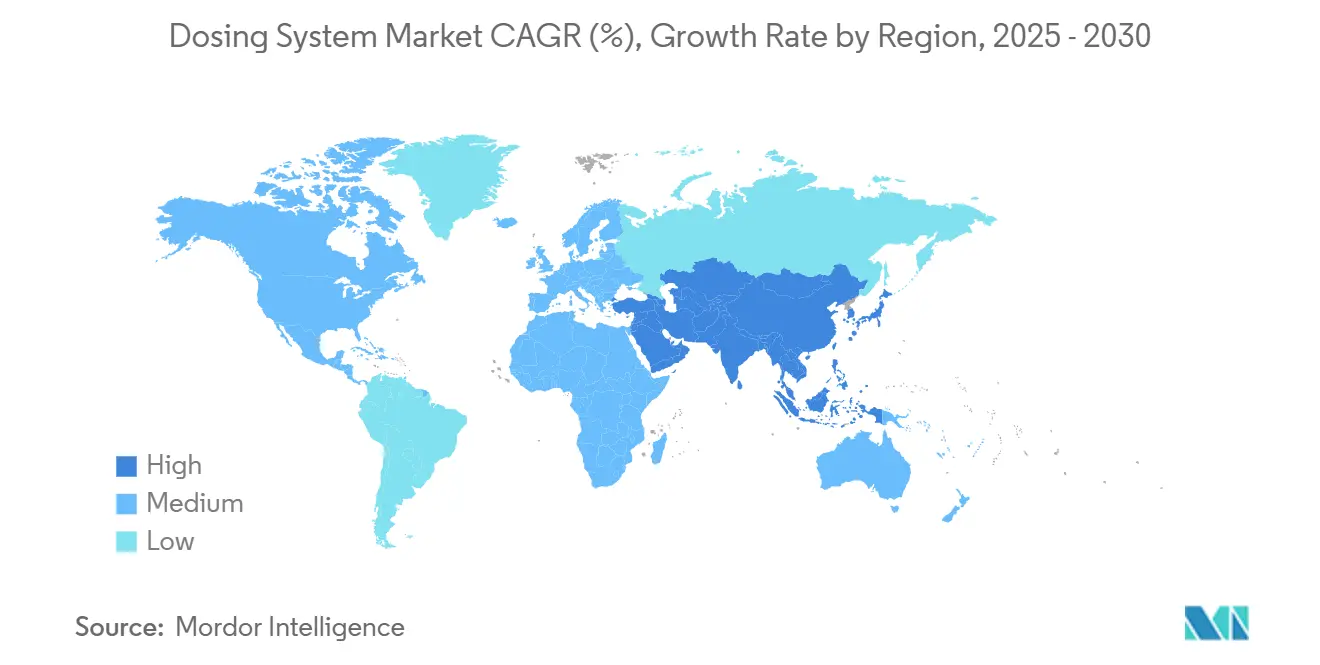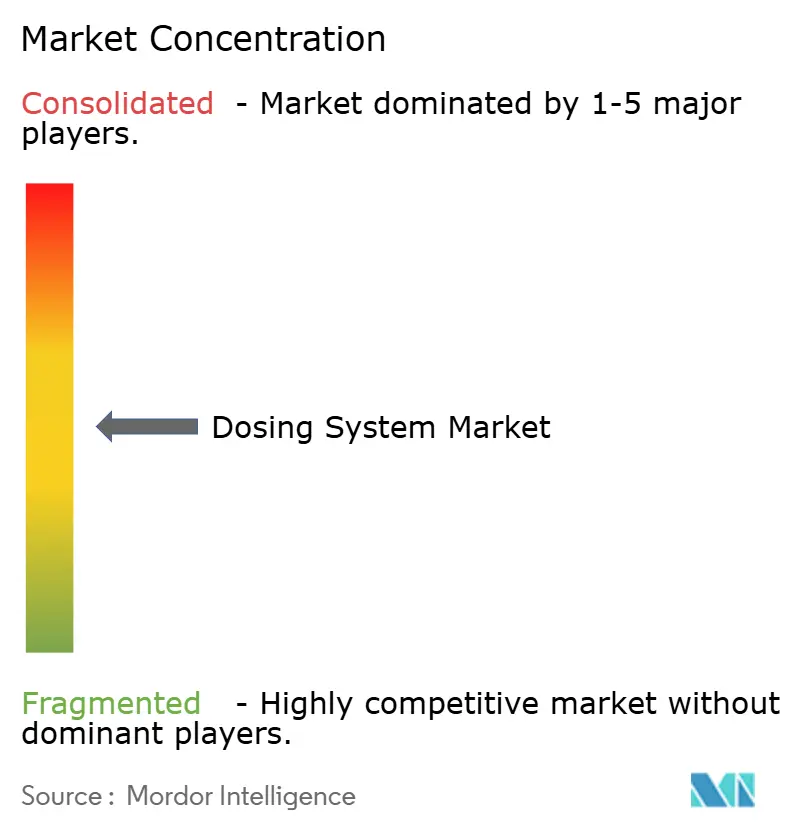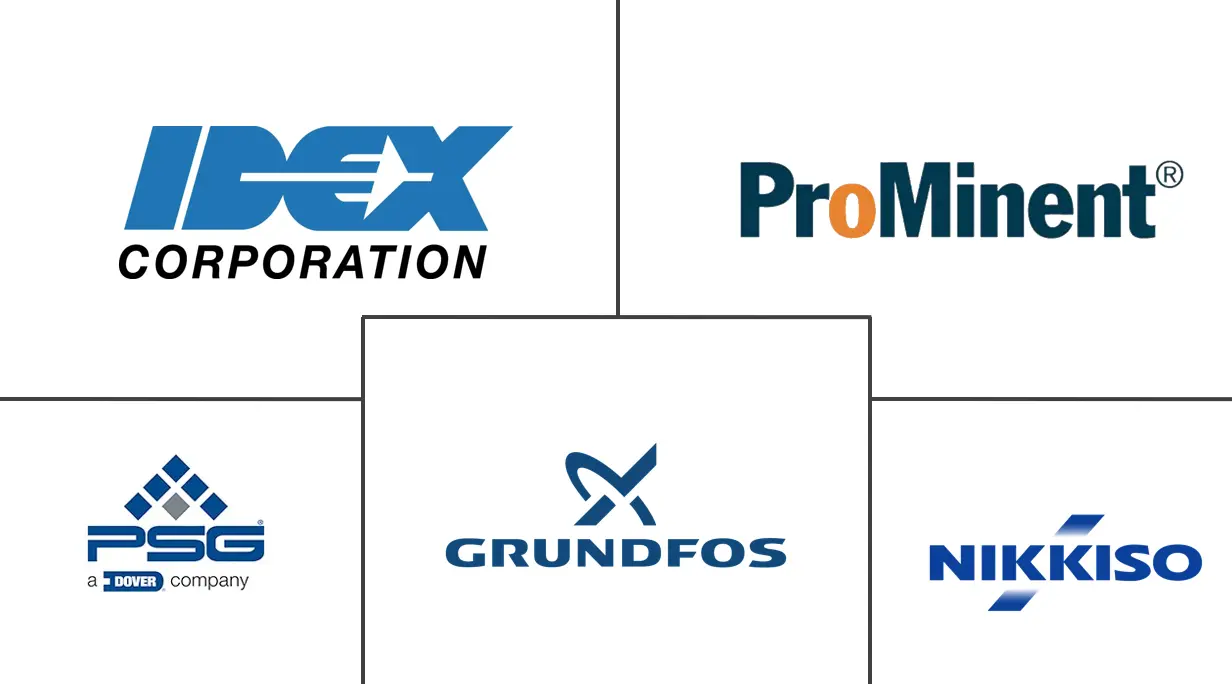Dosing System Market Size and Share

Dosing System Market Analysis by Mordor Intelligence
The Dosing System Market size is estimated at USD 6.29 billion in 2025, and is expected to reach USD 8.81 billion by 2030, at a CAGR of 6.98% during the forecast period (2025-2030).
Surging infrastructure upgrades in water treatment, stricter environmental regulations, and rising demand for precision chemical injection in the pharmaceutical and oil & gas industries are the primary growth catalysts. Automation and industrial IoT (IIoT) continue to reshape equipment specifications, while government-backed water security programs ensure steady capital outlays for utilities. Energy companies are also allocating larger budgets to enhanced-recovery chemical injection, and biologics producers require micro-dosing accuracy that conventional pumps cannot deliver. Supply-chain exposure in specialty polymer diaphragms remains a pricing risk, and cybersecurity worries could temper the pace of connected-pump adoption.
Key Report Takeaways
- By pump type, diaphragm technology held 48.12% of the dosing system market share in 2024, whereas peristaltic (hose) pumps are projected to rise at a 7.11% CAGR between 2025 and 2030.
- By application, water and wastewater treatment accounted for 38.23% of the dosing system market size in 2024, while the pharmaceuticals and biotechnology segment is forecast to grow the fastest at 7.96% through 2030.
- By geography, the Asia-Pacific region led with a 39.31% revenue share in 2024 and is projected to advance at a 7.32% CAGR through 2030.
Global Dosing System Market Trends and Insights
Drivers Impact Analysis
| Driver | (~) % Impact on CAGR Forecast | Geographic Relevance | Impact Timeline |
|---|---|---|---|
| Rising investments in water & wastewater treatment infrastructure | +1.0% | Global, with strongest impact in APAC and MEA emerging markets | Medium term (2-4 years) |
| Expansion of oil & gas enhanced-recovery chemical injection | +0.8% | North America, Middle East, with spillover to South America | Short term (≤ 2 years) |
| Stricter global hygiene standards in F&B processing | +0.6% | Global, with early adoption in Europe and North America | Medium term (2-4 years) |
| Environmental regulations tightening effluent limits | +0.7% | Europe, North America, with gradual expansion to APAC | Long term (≥ 4 years) |
| IIoT-enabled smart dosing & remote monitoring adoption | +1.0% | Global, led by developed markets with APAC manufacturing integration | Medium term (2-4 years) |
| Micro-dosing needs in biologics & cell-therapy production | +0.6% | North America, Europe, with emerging presence in APAC hubs | Long term (≥ 4 years) |
| Source: Mordor Intelligence | |||
Rising Investments in Water & Wastewater Treatment Infrastructure
Record public-utility spending is fueling the dosing system market. Australia’s National Water Grid Fund is allocating USD 2.5 billion for new plants, while Missouri American Water earmarked more than USD 500 million in 2024 to replace aging pipes and upgrade chemical feed stations [1]Missouri American Water, “Missouri American Water Announces 2024 Infrastructure Investment,” amwater.com. Utilities favor automated metering pumps that reduce chemical overuse, and real-time control platforms help operators comply with increasingly stringent discharge permits. In drought-prone regions, fine-tuned dosing ensures every liter is safeguarded, making precision pumping integral to long-term water security strategies.
Expansion of Oil & Gas Enhanced-Recovery Chemical Injection
Operators extend field life by injecting polymers, surfactants, CO₂, and nanoscale additives that mobilize trapped hydrocarbons, thereby increasing production. Chevron and Halliburton’s ZEUS IQ system now automates stage execution and adjusts chemical blends in real-time [2]Chevron, “ZEUS IQ™ Intelligent Fracturing,” chevron.com. Metering accuracy directly influences incremental recovery, so producers specify high-pressure diaphragm pumps with accuracy tolerances of ±1% or less. Growing investment in North American shale restimulation and mature-field projects in the Middle East underpins short-term pump demand.
Environmental Regulations Tightening Effluent Limits
The U.S. Environmental Protection Agency’s first national PFAS drinking-water limits since 1996 will channel USD 9 billion into remediation by 2026 [3]United States Environmental Protection Agency, “National Primary Drinking Water Regulation for PFAS,” epa.gov. Canada’s updated Wastewater Systems Effluent Regulations adopt risk-based compliance pathways that favor advanced chemical treatment. Industries face lower parts-per-trillion discharge caps and must dose multiple reagents with milliliter-level precision to stay within permit thresholds. Regulatory audits also require digital dosing logs, reinforcing the shift toward connected metering systems.
IIoT-Enabled Smart Dosing & Remote Monitoring Adoption
Cloud dashboards and predictive maintenance analytics enable operators to identify seal wear before catastrophic failure. ProMinent’s DULCONNEX platform streams real-time flow data, cutting unplanned outages and chemical wastage. Hospitals and bioprocess plants are deploying similar architectures to safeguard sterile production suites. Yet every new data node enlarges the cyber-attack surface, prompting pump OEMs to embed secure-by-design firmware and authenticated device gateways.
Restraints Impact Analysis
| Restraint | (~) % Impact on CAGR Forecast | Geographic Relevance | Impact Timeline |
|---|---|---|---|
| Availability of low-cost alternative pump technologies | -0.6% | Global, with strongest impact in price-sensitive APAC and MEA markets | Short term (≤ 2 years) |
| High maintenance & energy cost of high-pressure systems | -0.4% | Global, with particular impact in energy-intensive applications | Medium term (2-4 years) |
| Cyber-security risks in connected dosing equipment | -0.3% | Developed markets with high IIoT adoption rates | Medium term (2-4 years) |
| Supply volatility of specialty polymer diaphragms | -0.3% | Global, with concentration risk in key manufacturing regions | Short term (≤ 2 years) |
| Source: Mordor Intelligence | |||
Availability of Low-Cost Alternative Pump Technologies
Regional suppliers are marketing centrifugal and gear pumps equipped with rudimentary stroke-control kits at discounts of up to 30% compared to precision metering units. For basic chlorine or pH adjustment, many municipal plants in South Asia opt for these low-spec alternatives, thereby squeezing margins for premium OEMs. Established brands, therefore, emphasize life-cycle cost, tighter volumetric accuracy, and after-sales service to justify higher capital prices.
Cyber-Security Risks in Connected Dosing Equipment
IIoT gateways expose critical infrastructure to ransomware. Manufacturing ranked among the top three most-attacked sectors in 2024, and compromised chemical feeds could trigger regulatory shutdowns [4]World Economic Forum, “Global Cybersecurity Outlook,” weforum.org. Utilities weigh the benefits of remote monitoring against liability: a successful breach might poison water supplies or halt vaccine batches. The resulting caution can slow adoption of cloud-enabled pumps, especially in North America and the European Union, where data-protection statutes impose steep penalties for cyber lapses.
Segment Analysis
By Pump Type: Diaphragm Experience Underpins Market Leadership
Diaphragm units captured 48.12% of the dosing system market share in 2024, reflecting their leak-proof membranes and corrosion resistance, which are vital for handling aggressive acids and alkalis. The dosing system market size for diaphragm technology continues to expand in tandem with municipal disinfection projects and refinery desulfurization lines. Peristaltic designs are gaining traction at a 7.11% CAGR because single-use tubing eliminates cross-contamination, a decisive factor in biologics fill-finish suites. Progressive-cavity pumps remain the choice for shear-sensitive slurries in biogas digesters, an area bolstered by Atlas Copco’s purchase of Wangen Pumpen. Piston and plunger models meet niche demand in high-pressure offshore wells, where pulseless flow is critical.
Innovation centers on compact, servo-driven motors that hold flow variance below 0.5%. Watson-Marlow’s latest peristaltic portfolio delivers bidirectional accuracy, suited to continuous manufacturing skids. OEMs also integrate ceramic heads and PTFE diaphragms to overcome shortages of specialty polymers. These material advances insulate buyers from supply swings and help stabilize the dosing system market.

Note: Segment shares of all individual segments available upon report purchase
By Application: Water Treatment Volume Meets Pharmaceutical Precision
Water & wastewater treatment contributed 38.23% of the dosing system market size in 2024, thanks to large-scale demand for coagulants, flocculants, and disinfectants. Chloramine feed lines often run 24/7, rewarding pumps with low maintenance intervals and integrated chlorine-vacuum relief. Pharmaceuticals & biotechnology is the fastest-growing application, with a 7.96% CAGR, as micro-batch biologics migrate toward single-use reactors. Cell-therapy producers routinely program pumps to dispense sub-milliliter boluses during upstream inoculation, a task that exceeds the capabilities of traditional centrifugal devices.
The core sectors include oil and gas, chemical injection, food and beverage, sanitation, and pulp and paper bleaching. FDA’s 21 CFR 117 rule pushes food processors to validate every sanitizer dose. Meanwhile, modular RNA-production “biofoundries” such as Quotient Sciences’ GMP Biofoundry-in-a-Box™ rely on high-precision pumps to make 1 million vaccine doses daily. These emerging use cases diversify the dosing system market across industries and economic cycles.

Note: Segment shares of all individual segments available upon report purchase
Geography Analysis
The Asia-Pacific region generated the largest share of the dosing system market in 2024, at 39.31%, and is poised for a 7.32% CAGR through 2030. China's fast-tracked drug registration reforms, including a 45-day batch release for seasonal flu shots, encourage domestic biotech expansion and turbocharge smart pump demand. India's Jal Jeevan Mission finances chlorine-dosing skids for new rural water plants, while Southeast Asia's chemical industry is projected to reach USD 448 billion by 2030, deepening the regional customer base.
North America remains a technology bellwether as the EPA's PFAS standards unlock USD 9 billion for remediation through 2026. Utilities are retrofitting treatment trains with multi-channel metering pumps that handle coagulants, powdered-activated carbon, and ion-exchange resins in a single frame. Canada's new risk-based wastewater rules are driving automation in secondary plants, with digital pump logs streamlining compliance audits.
Europe records stable replacement demand, anchored in the Green Deal's sustainability goals. German and Nordic municipalities are shifting toward low-energy pumps that reduce power draw by up to 20%. The Middle East utilizes dosing systems for enhanced oil recovery and desalination brine conditioning, whereas key growth pockets include South African mining and Egyptian fertilizer production. Brazilian pulp mills and Argentine irrigators invest selectively in South America, but currency volatility tempers capital imports. Local assembly partnerships help international brands navigate tariff barriers and expand their market footprint in the dosing system market across emerging regions.

Competitive Landscape
The dosing system market is moderately fragmented. Dover Corporation broadened its scope with the 2025 acquisition of Cryo-Mach, adding cryogenic centrifugal competencies that complement its PSG metering lines. Grundfos invested DKK 1.8 billion in 2023 R&D to refine energy-efficient motors and IoT firmware. ProMinent’s DULCONNEX ecosystem differentiates through predictive-maintenance analytics, while niche makers focus on application depth: Watson-Marlow dominates peristaltic solutions for sterile fluids, and Ingersoll Rand’s 2025 purchase of UT Pumps expands its reach in biogas and carbon-capture dosing.
Supply-side challenges center on shortages of fluoro-polymer diaphragms and extended chip lead times for smart controllers. Players mitigate risk through dual-sourcing and vertical integration—Dover’s Carter Day asset buy boosts in-house pelletizer parts, lessening reliance on external vendors. Aftermarket service has become a key profit pillar; OEMs bundle remote diagnostics, cartridge kits, and operator training to secure annuity revenues. Emerging disruptors experiment with AI-guided flow tuning and green-hydrogen-ready materials, setting the stage for next-generation differentiation within the dosing system industry.
Dosing System Industry Leaders
-
Grundfos Holding A/S
-
Dover Corporation (PSG)
-
IDEX Corporation
-
ProMinent GmbH
-
Nikkiso Co., Ltd.
- *Disclaimer: Major Players sorted in no particular order

Recent Industry Developments
- January 2025: Dover Corporation integrated petrochemical drying assets from Carter Day into its MAAG business, strengthening plastics dewatering solutions.
- November 2024: Quotient Sciences has unveiled the inaugural GMP Biofoundry-in-a-Box™ (BiaB™) tailored for rapid RNA production.
- October 2024: Ingersoll Rand acquired APSCO, Blutek, and UT Pumps for a total of USD 135 million. This move aligns with Ingersoll Rand's strategy to broaden its product offerings and extend its global footprint.
- August 2024: Nordson Corporation closed its acquisition of Atrion, adding infusion-fluid delivery to its medical segment.
Global Dosing System Market Report Scope
Dosing system means the system of tanks, pumps or siphons, and piping located between the septic tank and soil absorption system, which is intended to apply a large quantity of settled wastewater to the absorption system in a short period of time.
The dosing system market report is segmented by type and application. By type, the market is segmented by diaphragm pump, piston pump, and other types. By application, the market is segmented by oil and gas, water and sewage treatment, chemicals, and other applications. The report also covers the market size and forecasts for the dosing system market across the major region. The report offers the market size and forecasts in revenue (USD) for all the above segments.
| Diaphragm Pumps |
| Piston/Plunger Pumps |
| Peristaltic (Hose) Pumps |
| Progressive Cavity Pumps |
| Gear and Other Positive-Displacement Pumps |
| Water and Wastewater Treatment |
| Oil and Gas |
| Chemicals and Petrochemicals |
| Food and Beverage |
| Pharmaceuticals and Biotechnology |
| Power Generation |
| Pulp and Paper |
| North America | United States |
| Canada | |
| Mexico | |
| Europe | Germany |
| United Kingdom | |
| France | |
| Italy | |
| Spain | |
| Russia | |
| Rest of Europe | |
| Asia-Pacific | China |
| India | |
| Japan | |
| South Korea | |
| ASEAN Countries | |
| Australia and New Zealand | |
| Rest of Asia-Pacific | |
| South America | Brazil |
| Argentina | |
| Rest of South America | |
| Middle East and Africa | Saudi Arabia |
| United Arab Emirates | |
| South Africa | |
| Egypt | |
| Rest of Middle East and Africa |
| By Pump Type | Diaphragm Pumps | |
| Piston/Plunger Pumps | ||
| Peristaltic (Hose) Pumps | ||
| Progressive Cavity Pumps | ||
| Gear and Other Positive-Displacement Pumps | ||
| By Application | Water and Wastewater Treatment | |
| Oil and Gas | ||
| Chemicals and Petrochemicals | ||
| Food and Beverage | ||
| Pharmaceuticals and Biotechnology | ||
| Power Generation | ||
| Pulp and Paper | ||
| By Geography | North America | United States |
| Canada | ||
| Mexico | ||
| Europe | Germany | |
| United Kingdom | ||
| France | ||
| Italy | ||
| Spain | ||
| Russia | ||
| Rest of Europe | ||
| Asia-Pacific | China | |
| India | ||
| Japan | ||
| South Korea | ||
| ASEAN Countries | ||
| Australia and New Zealand | ||
| Rest of Asia-Pacific | ||
| South America | Brazil | |
| Argentina | ||
| Rest of South America | ||
| Middle East and Africa | Saudi Arabia | |
| United Arab Emirates | ||
| South Africa | ||
| Egypt | ||
| Rest of Middle East and Africa | ||
Key Questions Answered in the Report
What is the current value of the dosing system market?
The dosing system market size is USD 6.29 billion in 2025.
Which pump type dominates global demand?
Diaphragm pumps lead with 48.12% revenue share thanks to their leak-proof construction and chemical compatibility.
Why is Asia-Pacific the largest regional market?
Rapid industrialization, water-infrastructure projects and expanding pharmaceutical manufacturing give Asia-Pacific 39.31% share and the fastest 7.32% CAGR.
How are environmental regulations influencing equipment design?
Stricter PFAS and wastewater limits push utilities to adopt high-precision, digitally logged metering pumps to guarantee compliance.
What role does IIoT play in future growth?
Smart dosing platforms that enable remote monitoring and predictive maintenance add 1.0% to forecast CAGR by cutting downtime and chemical waste.
Which application is growing the fastest?
Pharmaceuticals & biotechnology is projected to expand at a 7.96% CAGR as micro-dosing for biologics and cell-therapy becomes mainstream.
Page last updated on:



